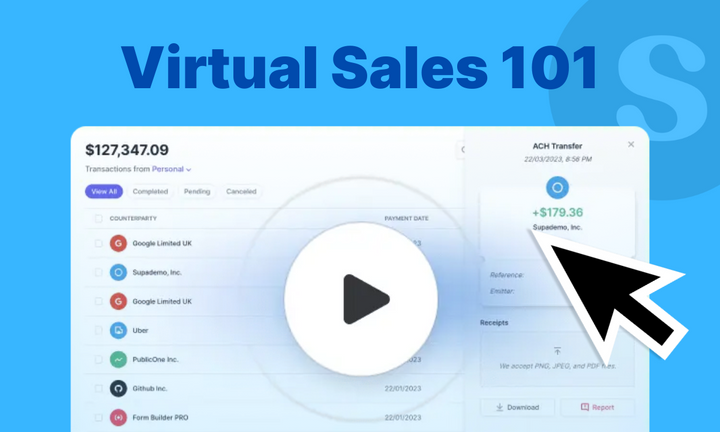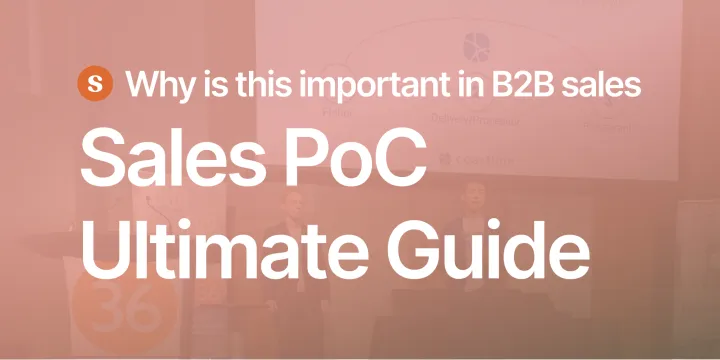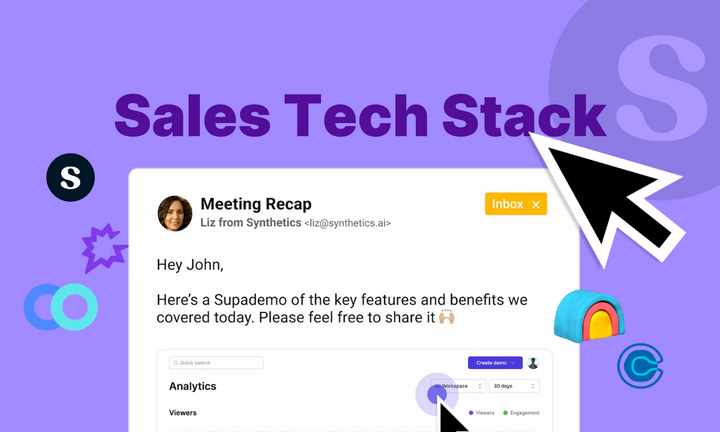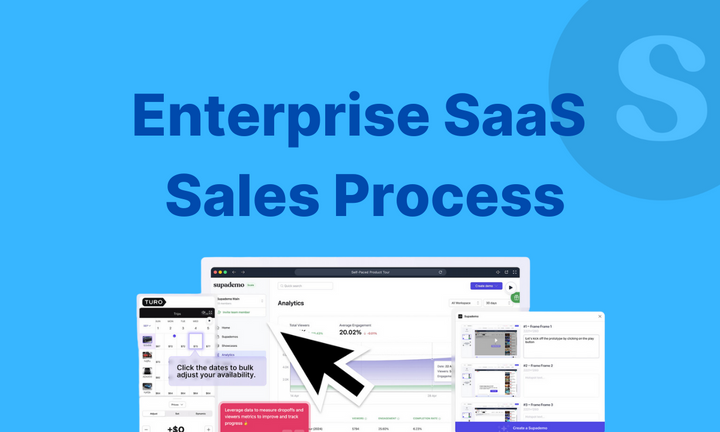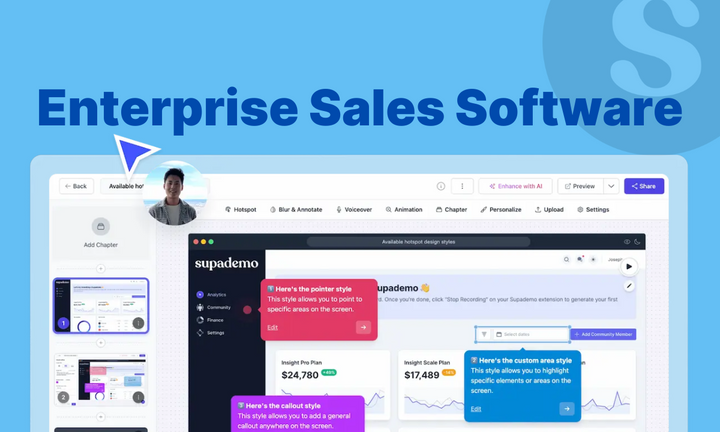In 2023, B2B online sales grew by 10%, reaching $3.36 trillion. This shows more businesses prefer buying and selling online rather than in person.
But selling online has its problems. Almost half of sales leaders say deals take longer to close, and many potential sales fall through because buyers can't make up their minds.
Without face-to-face meetings, it's harder to build trust with customers. Sales teams need to use technology to create personal connections with buyers during the sales process.
This guide will show you the good and bad parts of online selling and give you tips to succeed. We cover which tools to use and how to connect with customers online.
What is virtual sales?
Virtual sales transforms the traditional sales process for today's digital-first marketplace.
While the pandemic accelerated this shift, the movement toward digital engagement was already gaining momentum. This evolution demands a completely new approach. Today's sales professionals must master digital platforms to forge meaningful connections, craft tailored experiences, and address customer challenges—all without the benefit of physical presence.
The most successful virtual sales teams don't just adapt to digital tools; they leverage technology to create more responsive, insightful, and value-driven, personalized interactions that often surpass traditional methods in effectiveness and reach.
Without face-to-face interactions, building rapport can be challenging.
Sales teams need to be more intentional about their communication, ensuring they are transparent, responsive, and genuinely helpful. It's also crucial to have the right tech stack—tools that facilitate seamless communication, track interactions, and provide insights into customer behavior.
How to sell virtually?
Selling virtually isn't just about hopping on a Zoom call and sharing your screen. It's about crafting an experience that mirrors the personal touch of face-to-face interactions, but through digital mediums. Think of digital sales as "remote rapport building."
Here’s a roadmap to effective virtual selling:
1. Leverage technology for engagement
Anyone can throw together a demo or send a “personalized” email. But the key to truly engaging in virtual selling is about crafting an experience—one that makes your prospects feel seen and heard, even through a screen.
Technology is the tool, but experience is what sells.
Take Supademo, for example. Sure, it’s a tool for interactive demos, but the magic happens when sales reps use it not just to show a product, but to invite prospects into a dialogue. It’s like giving them a seat at the table without having to be physically there.
Here's an example of how product demos create an interactive user experience:
2. Master digital communication
Sales is no longer just about the pitch.
And when it comes to virtual selling, that means stepping away from one-size-fits-all messaging and focusing on deep personalization.
Take sales leaders like Brian Burns—he’s constantly talking about how virtual selling is about aligning with your buyer’s journey, not forcing them down a generic sales funnel. In fact, he’s got a great point that “buyers today are expecting personalization, and if you’re not giving it, you’re irrelevant.”
It's that kind of thinking that sets apart the average sellers from the ones who actually know how to build relationships in a digital world.
3. Build relationships remotely
Let’s talk about something we all know but maybe don’t always acknowledge—everyone is a salesperson.
If you're part of an organization, you’re always selling in one way or another. Whether it’s sharing an article, recommending a service, or just being a connector, you’re influencing people around you.
I had a moment recently that really made me realize this. A contact from LinkedIn reached out about an article I posted months ago. It wasn’t anything groundbreaking, but it sparked interest in a service we offer. And that’s when it hit me: This is social selling. It’s not about pushing your product at every turn—it’s about sharing valuable, relevant content that speaks to your network.
Trust in virtual sales comes from over-delivering on value at every touchpoint. Andy Gray in a LinkedIn article says, “The future of sales is not about selling at all, it’s about helping.”
It’s about giving your prospects a chance to interact with your product before you even ask them to buy. Show them how it will solve their problems. Give them real-time feedback. But more importantly, listen. The tools are just the vehicle; your ability to listen and respond in real-time is what builds trust.
4. Data-driven decisions
When we talk about demo tools like Supademo, it's not just about providing an interactive experience—it’s about getting real insights into how prospects are engaging with your product. And that’s where the magic happens.
Supademo’s analytics, for example, provide granular details like viewer-specific tracking, sorting, and filtering options. This isn’t just a high-level look at how many people have viewed your demo; it tells you exactly who is watching, what they’re focusing on, and even where they drop off.
This level of detail allows you to make hyper-targeted follow-ups, turning data into actionable insights.

Now, if you pair these insights with CRM tools like Salesforce or HubSpot, the results are amplified.
These platforms aren’t just tracking emails or calls. They’re tracking every touchpoint—email opens, website visits, interactions on social media—and creating a clear picture of where a prospect is in their buying journey.
It’s like a breadcrumb trail, right? Every time they engage with your content or interact with your brand, you get a little closer to understanding their needs.
And here’s where it gets really interesting: the data doesn’t just give you insights into individual prospects—it also helps you spot trends across the board. For example, let’s say you notice that a lot of prospects are engaging with content related to product features but aren’t spending as much time on pricing. That’s a signal. Maybe they need more education on how the product works before they’re ready to talk dollars.

Best practices for virtual selling
Virtual selling requires a well-thought-out strategy, combining the right tools with effective communication techniques.
Here are some best practices to enhance your virtual sales approach:
| Best Practice | Strategy | Actionable |
|---|---|---|
| Developing a Strategic Virtual Sales Approach | Establish clear strategy and objectives | ✅ Define goals for virtual selling |
| Align sales strategy with business objectives | ✅ Ensure team alignment with company vision | |
| Develop a scalable, adaptable sales process | ✅ Create a process that adapts to changing markets | |
| Building a Focused Sales Team | Hire for the right skills (digital communication, self-motivation, adaptability) | ✅ Focus on hiring individuals with digital skills |
| Provide ongoing training and development | ✅ Implement regular training programs | |
| Leveraging Technology for Sales Success | Integrate CRM, demo, and communication tools | ✅ Ensure seamless integration of key sales tools |
| Streamline workflows using automation | ✅ Use tools that automate repetitive tasks | |
| Ensuring Accessibility and Agility in Sales Processes | Maintain flexibility in sales workflows | ✅ Ensure processes can adapt to customer feedback |
| Ensure all resources are easily accessible for remote teams | ✅ Implement cloud-based solutions for resource sharing | |
| Enable rapid response to changing customer needs | ✅ Keep sales processes agile and ready to pivot | |
| Importance of Effective Communication and Metrics Tracking | Foster clear and concise communication | ✅ Encourage transparency in team messaging |
| Track sales performance metrics regularly | ✅ Monitor key metrics like conversion rates, engagement | |
| Regularly analyze data to refine sales strategy | ✅ Use performance data to optimize virtual sales strategies |
1. Developing a strategic virtual sales approach
In the digital marketplace, consistency is key. But it's more than just sticking to a process; it’s about being adaptable. Think about it like this—virtual selling is like cooking with an open recipe. You have all the ingredients (technology, communication tools, data), but how you use them depends on your audience and the situation at hand.
Building a focused sales team
Virtual sales isn’t for everyone. You need to hire self-starters who are highly independent but also know how to collaborate digitally. These folks should be comfortable with technology and know how to use it to their advantage—whether it’s CRM systems, video conferencing tools, or data analytics platforms.
You need to encourage sales teams to constantly improve their virtual selling skills. This might be through weekly role-playing sessions, simulated calls, or even creating a peer-mentoring environment where experienced reps help newer ones refine their pitches.
Leveraging technology for sales success
CRM software like Zoho CRM keeps your pipeline organized, but it's the integration with video conferencing tools like Zoom and interactive demo platforms like Supademo that truly power up the experience.

A great example of this in action comes from LinkedIn’s own virtual sales team. They swear by leveraging a fully integrated tech stack—combining their CRM, video tools, and LinkedIn Sales Navigator to help reps track leads, engage effectively, and close remotely.
Ensuring accessibility and agility in sales processes
It all comes down to creating a culture of accountability and recognition. This can be achieved through digital check-ins, but also by celebrating wins. Even small ones. Whether it's through a team Slack channel or a company-wide meeting, recognizing achievements helps keep morale high.
I’ve seen a lot of companies use gamification to keep reps engaged. When your team feels seen and valued, they are more agile.
Importance of effective communication and metrics tracking
Conversion rates are the bottom line, but the engagement level is a true reflection of how effective your reps are in building rapport virtually.
And the beauty of virtual sales is that you can measure that engagement so much more easily. You can track how much time a prospect spends on a demo, what sections they click on the most, or whether they’re replying to follow-up emails. This level of insight allows you to coach your reps to focus on the areas where engagement is highest.
2. Creating a tech-stack sales reps love
A solid tech stack is critical for virtual sales success. Here are the core tools to equip your sales team:
Interactive demo software
Solutions like Supademo allow sales reps to deliver interactive demos that are engaging and impactful, providing a personalized experience for each prospect.
Communication tools
Zoom, Microsoft Teams, and Google Meet are essential for video calls and meetings. Invest in platforms with interactive capabilities such as virtual whiteboards, screen sharing, and chat.
Prospecting tools
Prospecting tools like LinkedIn Sales Navigator and Snov.io help identify potential leads, making it easier for sales teams to engage with the right prospects at the right time.
CRM software
A robust CRM, such as Zoho CRM, helps manage relationships and sales opportunities, ensuring that no lead is forgotten and that every prospect is nurtured through the sales cycle.
Content-sharing technology
Platforms like HighSpot and Seismic help centralize content and make it easily accessible to sales reps. These tools allow sales teams to share up-to-date enablement content and track engagement.
3. Building a repository for sales reps who sell virtually
We're living in an age of information overload, and sales reps are constantly juggling multiple tasks. Having a centralised content repository to have quick access to sales collateral such as case studies, product brochures, and demo scripts is key.
Create a searchable hub
Think about it this way: a sales rep is on a Zoom call with a prospect, and they need to pull up a product brochure or case study to close the deal. If it takes them more than a couple of clicks, they're already at a disadvantage.
Platforms like Seismic are game changers here. Not only do they help organise and store materials, but they also allow reps to see which pieces of content are resonating with their prospects, giving them instant feedback on what’s working.
Enablement content for virtual sales
A successful content repository isn’t just about sales collateral—it also needs to house enablement content. This includes things like training materials, pitch decks, and even role-play scenarios. When a new hire joins, the ability to quickly onboard them with virtual demo walkthroughs or product tutorials is essential.
Streamline onboarding
Just like every person comes with a JTBD mindset, you can best serve customers with different or a combination of interactive onboarding demos. Three of the widely implemented demo types include:
➡️ Linear walkthrough (Guided, step-by-step demo)
➡️ Demo showcases (Self-paced collection of multiple demos)
➡️ Demo branching (Conditional, "choose your journey" demo)
4. Tracking the right metrics
With limited face-to-face interactions, it’s critical to measure success at each stage of the sales process. Here are key metrics for tracking sales performance:
Engagement metrics
Look at engagement metrics—things like email open rates, video view times, and meeting attendance. High engagement often leads to better conversions.
Conversion rates
Here’s the kicker: conversion rates—how many meetings actually end in closed deals—is the ultimate metric for sales reps to focus on. Analyze what tactics are leading to the most conversions.
Customer feedback
Tracking customer feedback through surveys and follow-ups also gives you crucial insight into how well the experience is resonating with prospects.
Watch a demo of Canny.io, a feedback management platform designed to help businesses collect, organize, and act on customer feedback efficiently.
5. Training your virtual sales team
Training is one of the most important factors in virtual sales success. To succeed in this environment, your sales team needs to be proficient in using digital tools, managing relationships, and closing deals remotely.
Ongoing training
Virtual selling isn’t static; it evolves rapidly with new tools, changing buyer behaviors, and shifting expectations. Continuous training is key. Whether it’s mastering digital tools like your CRM or learning new virtual selling techniques, this is something that should never stop.
Pitch practice
Don’t forget about role-play scenarios—mock demos or simulated calls can boost confidence and ensure your team is always sharp.
Mentorship programs
Pairing new hires with seasoned reps accelerates their learning and gives them a real-world perspective that can’t be taught in a textbook.
6. Follow up to stay top of mind
Follow-up is crucial—and I don’t mean the generic, “Just checking in” emails. Here’s how you can ensure your sales reps stay top of mind:
Personalized emails
Tailored emails that recap your meeting, add value, and include resources that address specific pain points are a must.

Phone calls or video check-ins
Use calls or video follow-ups to maintain a personal touch, especially when moving a prospect through the final stages of the sales cycle.
Engagement on social media
Here’s a strategy I’ve seen work wonders: engaging with prospects on social media. A quick LinkedIn comment on their latest post or a tweet acknowledging their achievement keeps you visible and engaged, without being pushy.
7. Use the best virtual selling tools
To succeed in virtual selling, sales teams must leverage the best tools available. Here’s a list of essential tools for virtual sales:
| Tool Category | Examples | Purpose and Strategic Value |
|---|---|---|
| Interactive Demo Software | Supademo | Enables personalized, real-time product demos that engage prospects. These tools drive deeper connection and confidence by showcasing your product’s value in action. |
| Video Creation Tools | Loom | Allows sales reps to send personalized video messages, providing a human touch and increasing engagement through visual storytelling. |
| Virtual Meeting Software | Zoom, Microsoft Teams | Facilitates face-to-face, remote interactions, essential for building rapport, managing complex sales, and maintaining engagement. |
| Call Recording and Note-Taking Tools | Gong.io, Chorus.ai | Records and analyzes calls, providing actionable insights for sales teams to refine techniques and improve performance. |
| Digital Sales Rooms | Distribute | Creates a collaborative virtual space for prospects to access content, interact with teams, and track their sales journey, enhancing engagement and shortening sales cycles. |
Wrapping Up!
Virtual selling is a blend of the right technology, continuous learning, and creating a personal, value-driven experience at every touchpoint. If you get that formula right, it’s not just about selling—it’s about building relationships and delivering ongoing value that stays with your prospects, long after the call ends.
The right tools—like Supademo’s interactive demos—combined with best practices in training, communication, and metrics tracking, can enable sales teams to thrive in a virtual environment. Adopting these strategies will not only help you close deals faster but also create lasting, meaningful relationships with your customers.
Want a hands-on trial? Try Supademo’s free plan and see the difference for yourself.
FAQs
What is virtual sales?
Virtual sales refers to engaging with prospects and customers remotely using digital tools like video conferencing, email, and interactive demos.
How is virtual selling different from traditional in-person sales?
Virtual selling occurs through digital channels, while traditional sales involve face-to-face meetings. Virtual sales require different engagement techniques and tools.
What tools do I need to run an effective virtual sales process?
CRM software, video conferencing tools, demo platforms, content sharing tools, and sales analytics software are all essential for virtual sales.
How can I build trust with prospects in a virtual environment?
Building trust virtually involves clear communication, personalized engagement, and delivering consistent value through content and interactions.
What are best practices for running successful virtual sales meetings?
Ensure clear communication, maintain engagement with interactive tools, and follow up strategically after each meeting to keep prospects engaged.
How do I deliver compelling product demos virtually?
Use interactive demo platforms and ensure that demos are tailored to the prospect's specific needs and pain points.
Can virtual sales work for large enterprise deals?
Yes, virtual sales can be effective for large deals, but they require a more personalized and strategic approach to address complex needs.
What metrics should I track to measure virtual sales success?
Track engagement, conversion rates, and feedback from prospects to measure success and refine your virtual sales process.
How do I keep prospects engaged throughout a virtual sales cycle?
Leverage interactive tools, provide valuable content, and maintain regular, personalized follow-ups to keep prospects engaged.
What are the biggest challenges in virtual selling—and how can I overcome them?
Challenges include maintaining engagement and building trust. Overcome these by using the right tools, fostering open communication, and consistently delivering value at each stage of the sales process.



